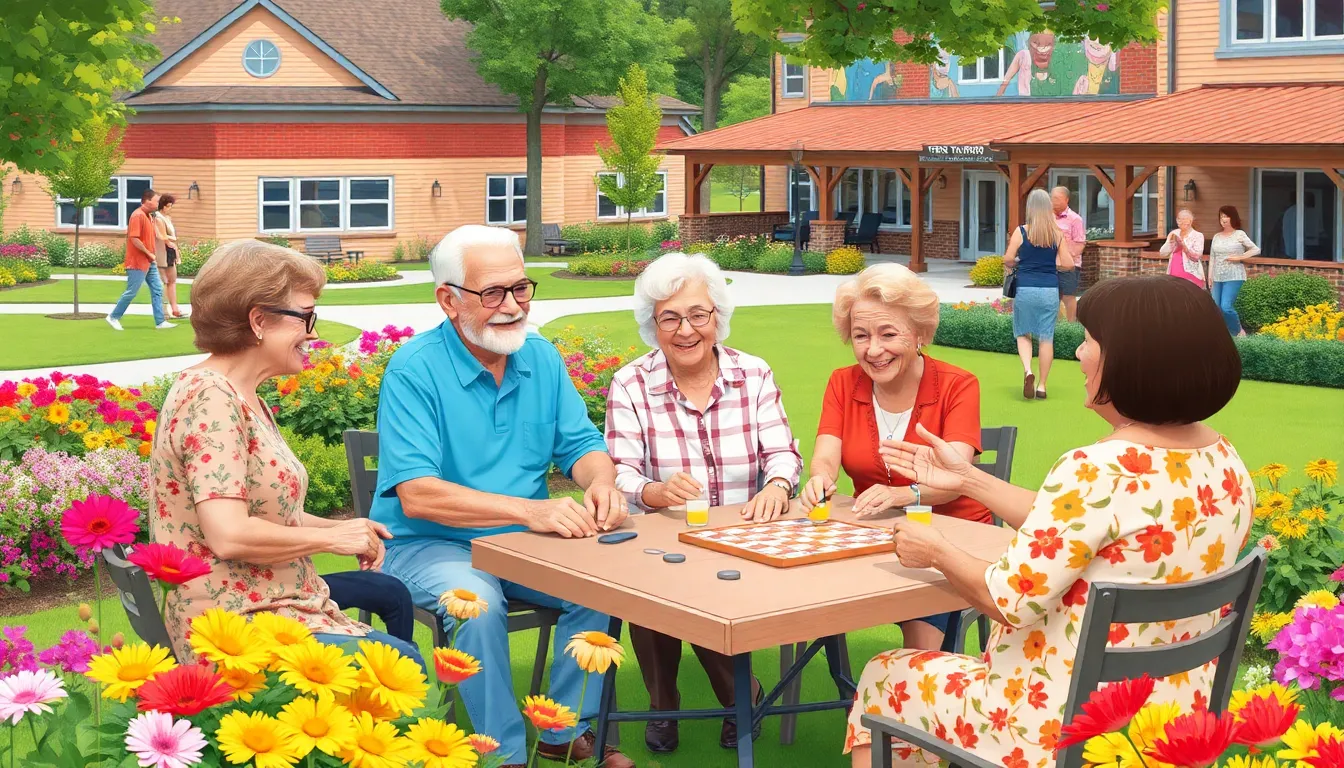Retirement isn’t just about putting your feet up and sipping lemonade. It’s about finding a vibrant community where every day feels like a new adventure. Imagine living in a place that offers not just a roof over your head but a social calendar packed with activities, laughter, and friendships waiting to blossom.
Choosing the best retirement community can feel overwhelming, but it doesn’t have to be. Whether it’s a sunny spot by the beach or a cozy nook in the mountains, there’s a perfect place out there for everyone. In this guide, we’ll explore the top retirement communities that promise not just a home, but a lifestyle filled with joy, connection, and maybe even a little mischief. After all, who says retirement can’t be a blast?
Table of Contents
ToggleOverview of Retirement Communities
Retirement communities provide a vibrant environment for active seniors. These communities often focus on social engagement through various activities and events. Many retirees find that living among peers fosters friendships and connections.
Amenities play a crucial role in enhancing the retirement experience. Golf courses, fitness centers, and swimming pools commonly attract residents seeking an active lifestyle. On-site services, such as dining options and health care, create convenience for those who prefer staying close to home.
Types of retirement communities vary significantly, catering to different lifestyle preferences. Independent living communities offer freedom while providing limited assistance. Assisted living facilities deliver more comprehensive support for daily tasks, while continuing care retirement communities (CCRCs) allow a seamless transition from independent to higher levels of care.
Location remains a significant factor for many retirees. Coastal and mountainous areas often appeal to those looking for scenic views and recreational opportunities. Urban communities attract seniors who enjoy cultural activities and social events.
Safety and security also matter greatly for potential residents. Gated entries, security personnel, and wellness checks contribute to a sense of comfort.
Selecting the right retirement community involves thorough research and consideration. Prospective residents should visit multiple locations, attend events, and interact with current residents. Such interactions provide insights into daily life, community culture, and available activities.
By prioritizing social engagement, safety, amenities, and location, retirees can find a community that meets their desires and enhances their quality of life.
Key Factors in Choosing Retirement Communities

Selecting a retirement community involves multiple key factors that can greatly influence the overall experience. Evaluating location, amenities, and social engagement enhances the decision-making process.
Location Considerations
Choosing the right location is essential for retirees. Geographic preferences vary widely, with some favoring coastal views while others lean toward mountainous landscapes. Urban settings appeal to those who enjoy access to cultural events and entertainment. Accessibility to family and friends often plays a significant role, as proximity fosters connections. Researching local climates and recreational offerings can also enhance happiness and satisfaction.
Amenities and Services
Evaluating amenities is crucial when selecting a community. Features such as golf courses, fitness centers, and swimming pools contribute to an active lifestyle. On-site dining options facilitate both convenience and socialization. Health care services should be readily available, ensuring peace of mind among residents. Expansive walking trails, hobby rooms, and art studios enrich daily life, encouraging creativity and leisure.
Social Activities and Community Engagement
Active social engagement promotes a vibrant retirement experience. Communities that offer diverse activities, such as game nights, exercise classes, and cultural outings, attract a wide range of interests. Regular events encourage friendships and social interactions among residents. Engaging in volunteer opportunities can also foster a sense of purpose. Ultimately, a lively atmosphere significantly enhances quality of life and overall happiness in retirement communities.
Top Retirement Communities in the U.S.
Numerous retirement communities across the U.S. offer vibrant social environments tailored for active lifestyles. Here’s a look at three top choices.
Community 1: Highlighted Features
This community excels in offering a wide range of amenities. Residents enjoy a state-of-the-art fitness center along with multiple walking trails. Regular social events, including game nights and art classes, foster engagement and friendships. Furthermore, dining options provide a variety of healthy meal choices. Access to on-site healthcare ensures peace of mind for residents, enabling them to focus on an active lifestyle.
Community 2: Highlighted Features
An impressive selection of recreational facilities defines this community. Residents participate in golf, swimming, and yoga classes. Weekly excursions to local attractions keep the social calendar full. Multiple dining venues create a diverse culinary experience, catering to various tastes. Proximity to shopping centers and parks enhances convenience and ease of living, making daily activities enjoyable.
Community 3: Highlighted Features
This community stands out for its emphasis on lifelong learning. Residents engage in workshops and lecture series covering a wide array of topics. Beautifully landscaped gardens create serene spaces for relaxation. Organized volunteer opportunities enrich connections with the local area. Moreover, access to public transport simplifies trips to nearby cultural events, maximizing enjoyment and exploration.
Cost Considerations for Retirement Communities
Cost factors play a crucial role when selecting a retirement community. Monthly fees typically cover rent, basic utilities, and access to community amenities. Pricing structures can vary significantly based on location, with urban areas generally commanding higher rates than rural ones.
Initial entrance fees frequently accompany many retirement communities. These one-time payments may range from thousands to several hundred thousand dollars, depending on the amenities and level of care offered. Additionally, ongoing maintenance fees contribute to overall expenses, financing facility upkeep and services.
Different types of communities present varying cost scenarios. Independent living setups often have lower associated costs, while assisted living facilities typically demand higher fees due to additional services provided. Continuing care retirement communities (CCRCs) generally provide an all-in-one pricing model that combines housing, healthcare services, and access to additional amenities.
It’s important for prospective residents to understand potential extra fees. Services like dining, personal care, and recreational activities may incur additional charges. Transparency from management regarding these costs can facilitate informed decision-making.
Budgeting for retirement should include an evaluation of potential medical expenses. As individuals age, healthcare needs might increase, leading to heightened costs. Insurance policies can mitigate some expenses; reviewing coverage becomes vital before committing to a community.
Researching total costs across multiple communities allows individuals to compare what’s included in the fees. One community might provide extensive amenities for a slightly higher cost, while another may charge less but offer limited services. Gathering this information enables retirees to find the right balance between affordability and quality of life as they select their ideal retirement community.
Tips for Transitioning to a Retirement Community
Transitioning to a retirement community can feel overwhelming. First, visit several communities to assess their ambiance and offerings. Engaging with current residents provides valuable insights into daily life and community culture.
Consider personal interests while exploring communities. Those who enjoy fitness may prioritize amenities like gyms and walking trails. Others might focus on social activities, so a vibrant calendar of events becomes essential.
Evaluate the layout of the community, ensuring it suits mobility needs. Accessibility features, such as ramps and elevators, significantly enhance comfort and safety. Cultivating a sense of familiarity aids in the adjustment process.
Don’t rush the transition. Take time to downsize belongings and decide what items to keep. Organizing essentials can create a streamlined move, reducing stress.
Communication with family and friends plays a pivotal role in a smooth transition. Involving loved ones in the decision process fosters support and understanding. Regular calls or visits can ease feelings of loneliness during adjustment.
Embrace opportunities to participate in community activities. Joining groups or classes allows new residents to connect with peers. Many communities offer orientation sessions designed to help ease newcomers into their social fabric.
Establishing a routine promotes comfort in the new environment. Integrating familiar activities into daily life, such as exercise or hobbies, enhances a sense of belonging. Staying open to new experiences facilitates quicker adaptation.
Understanding the community structure supports informed decisions about social engagement. Some communities focus on shared interests or hobbies, encouraging friendships among residents. Prioritize understanding the available resources to ensure fulfilling interactions in the new setting.
Finding the right retirement community is essential for a fulfilling and active lifestyle. By prioritizing social engagement amenities and location, retirees can create a vibrant and enjoyable new chapter in their lives. Each community offers unique features that cater to different interests and needs, making thorough research and personal visits crucial.
It’s important to consider factors like safety, health services, and recreational opportunities when making a choice. Engaging with current residents can provide valuable insights and help prospective residents envision their future. With the right community, retirement can be a time of joy connection and growth.



